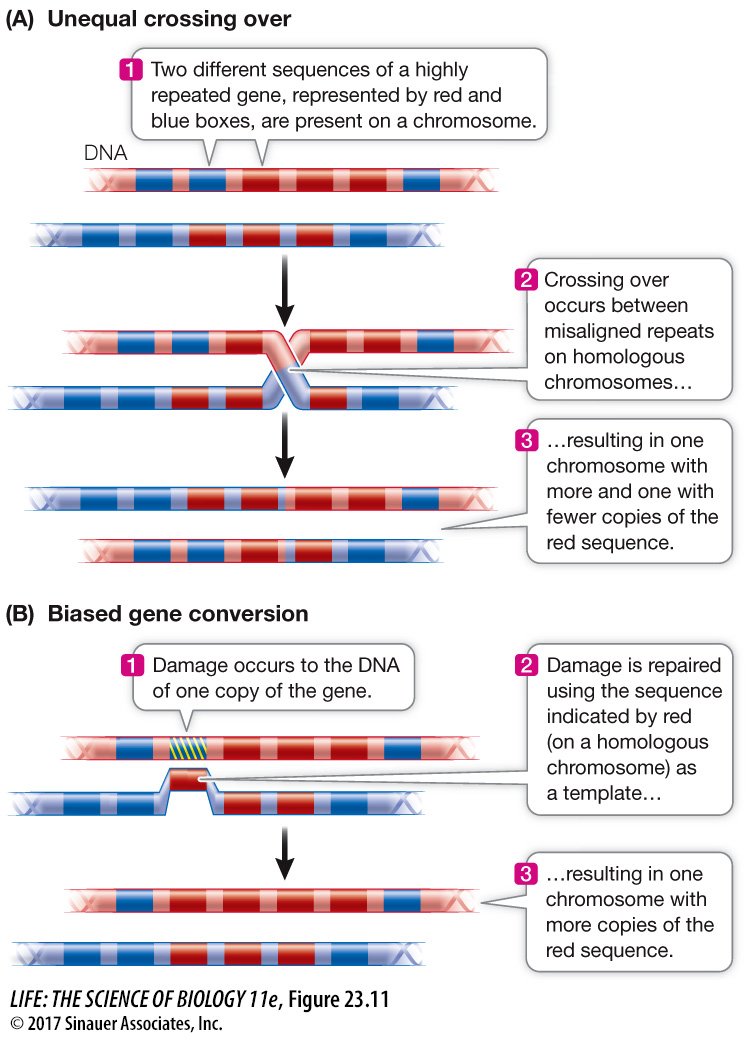Some gene families evolve through concerted evolution
Although the members of the globin gene family have diversified in form and function, the members of many other gene families do not evolve independently of one another. For instance, almost all organisms have many copies (up to thousands) of the ribosomal RNA genes. Ribosomal RNA (rRNA) is the principal structural element of ribosomes and, as such, has a primary role in protein synthesis. Every living species needs to synthesize proteins, often in large amounts (especially during early development). Having many copies of the rRNA genes ensures that organisms can rapidly produce many ribosomes and thereby maintain a high rate of protein synthesis.
Like all portions of the genome, ribosomal RNA genes evolve, and differences accumulate in the rRNA genes of different species. But within any one species, the multiple copies of the rRNA genes are very similar, both structurally and functionally. This similarity makes sense because, ideally, every ribosome in a species should synthesize proteins in the same way. In other words, within a given species, the multiple copies of these rRNA genes are evolving in concert with one another, a phenomenon called concerted evolution.
Animation 23.1 Concerted Evolution
How does concerted evolution occur? Two different mechanisms appear to be responsible. The first of these is unequal crossing over. When DNA is replicated during meiosis in a diploid species, the homologous chromosome pairs align and recombine by crossing over (see Key Concept 11.4). In the case of highly repeated genes, however, it is easy for genes to become displaced in alignment, since so many copies of the same genes are present on the chromosomes (Figure 23.11A). The end result is that one chromosome may gain extra copies of the repeat and the other chromosome may have fewer copies of the repeat. If a new substitution arises in one copy of the repeat, it can spread to new copies (or be eliminated) through unequal crossing over. Thus, over time, a novel substitution will either become fixed or it will be lost entirely. In either case, all copies of the repeat will remain very similar to one another.

The second mechanism that produces concerted evolution is biased gene conversion. This mechanism can be much faster than unequal crossing over and has been shown to be the primary mechanism for concerted evolution of rRNA genes. DNA strands are frequently broken and repaired (see Key Concept 13.4). At many times during the cell cycle, the genes for ribosomal RNA are clustered close together. If damage occurs to one of the genes, a copy of the rRNA gene on another chromosome may be used to repair the damaged copy, and the sequence that is used as a template can thereby replace the original sequence (Figure 23.11B). In many cases, this repair system appears to be biased in favor of using particular sequences as templates for repair, and thus the favored sequence rapidly spreads across all copies of the gene. In this way, changes may appear in a single copy and then rapidly spread to all the other copies.
Regardless of the mechanism responsible, the net result of concerted evolution is that the copies of a highly repeated gene do not evolve independently of one another. Mutations still occur, but once they arise in one copy, they either spread rapidly across all the copies or are lost from the genome completely. This process allows the products of each copy to remain similar over time in both sequence and function.
We have seen how the principles and methods of molecular evolution have opened new vistas in evolutionary biology. Next we will consider some of the practical applications of this field.